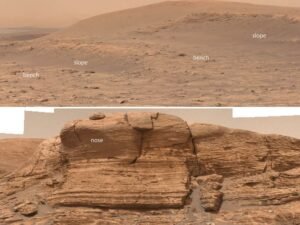Odd formations on Mars discovered by the Curiosity rover, initially dismissed as ordinary strata, may be signs that the red planet was once home to a vast array of habitable rivers potentially teeming with alien life.
If confirmed, the findings would add to the growing body of evidence that Mars was not only wet in the past but had longstanding bodies of water capable of harboring all kinds of life forms.
“Our research indicates that Mars could have had far more rivers than previously believed, which certainly paints a more optimistic view of ancient life on Mars,” said Benjamin Cardenas, assistant professor of geosciences at Penn State and lead author on a new paper announcing the discovery.“It offers a vision of Mars where most of the planet once had the right conditions for life.”
Simulations Find Compelling Evidence for Habitable Ancient Martian Rivers
Known as bench-and-nose landforms, the telltale formations interested researchers because they are typically made by rivers of flowing water over extensive periods on Earth. This similarity led the team to build computer models designed to simulate events from Mars’ past and see if ancient rivers could have made similar formations. Their findings could dramatically alter the search for life on Mars.


First, the Penn State team input data gathered by satellites and images captured by Curiosity into their simulations. Next, they input detailed 3D scans of rock layers, a.k.a. strata, deposited over millions of years beneath the Gulf of Mexico. This data was collected 25 years ago by oil companies, and the researchers say it is a perfect analog for Mars.
After running their simulations, the team found something incredible. According to the press release announcing the new findings, “the model revealed erosional Martian landscapes that formed topographic benches and noses, rather than fluvial ridges, appearing almost identical to landforms observed by the Curiosity rover inside the Gale crater.”
This meant that rivers likely not only flowed on Mars in its ancient past but were way more commonplace than previously thought. The research team says this would be incredibly significant, as these additional rivers dramatically increase the chances that ancient life lived and potentially called Mars home.
“This suggests that there could be undiscovered river deposits elsewhere on the planet and that an even larger section of the Martian sedimentary record could have been built by rivers during a habitable period of Mars’ history,” Cardenas explained. In fact, he noted that river corridors on earth are “so important for life, chemical cycles, nutrient cycles, and sediment cycles,” and that “everything is pointing to these rivers behaving similarly on Mars.”
Formations on Mars Adding to Case for the Planet Supporting Ancient Life
The researchers note that previous analyses of the red planet have identified possible locations of lakes and rivers, with the latter of those identified by something known as fluvial ridges. Like the bench-and-nose formations revealed by the team’s simulations, these ridges are also typically associated with rivers on Earth. But in this case, the team says they found signs of river deposits “that are not associated with fluvial ridges, but rather bench-and-nose landforms that have never been linked to ancient river deposits.”
Taken together with signs of ancient lakes, evidence of an ancient Martian atmosphere, and dozens of other clues pointing to a wet, life-friendly planet that lasted for hundreds of millions of years, this new data is helping to make a convincing case that life likely not only lived, but thrived, but these unique formations on Mars are simply another sign that a majority of the planet was habitable and not just a few select areas.
“We’re finding evidence that Mars was likely a planet of rivers,” Cardenas said. “We see signs of this all over the planet.”
Christopher Plain is a Science Fiction and Fantasy novelist and Head Science Writer at The Debrief. Follow and connect with him on X, learn about his books at plainfiction.com, or email him directly at christopher@thedebrief.org.

